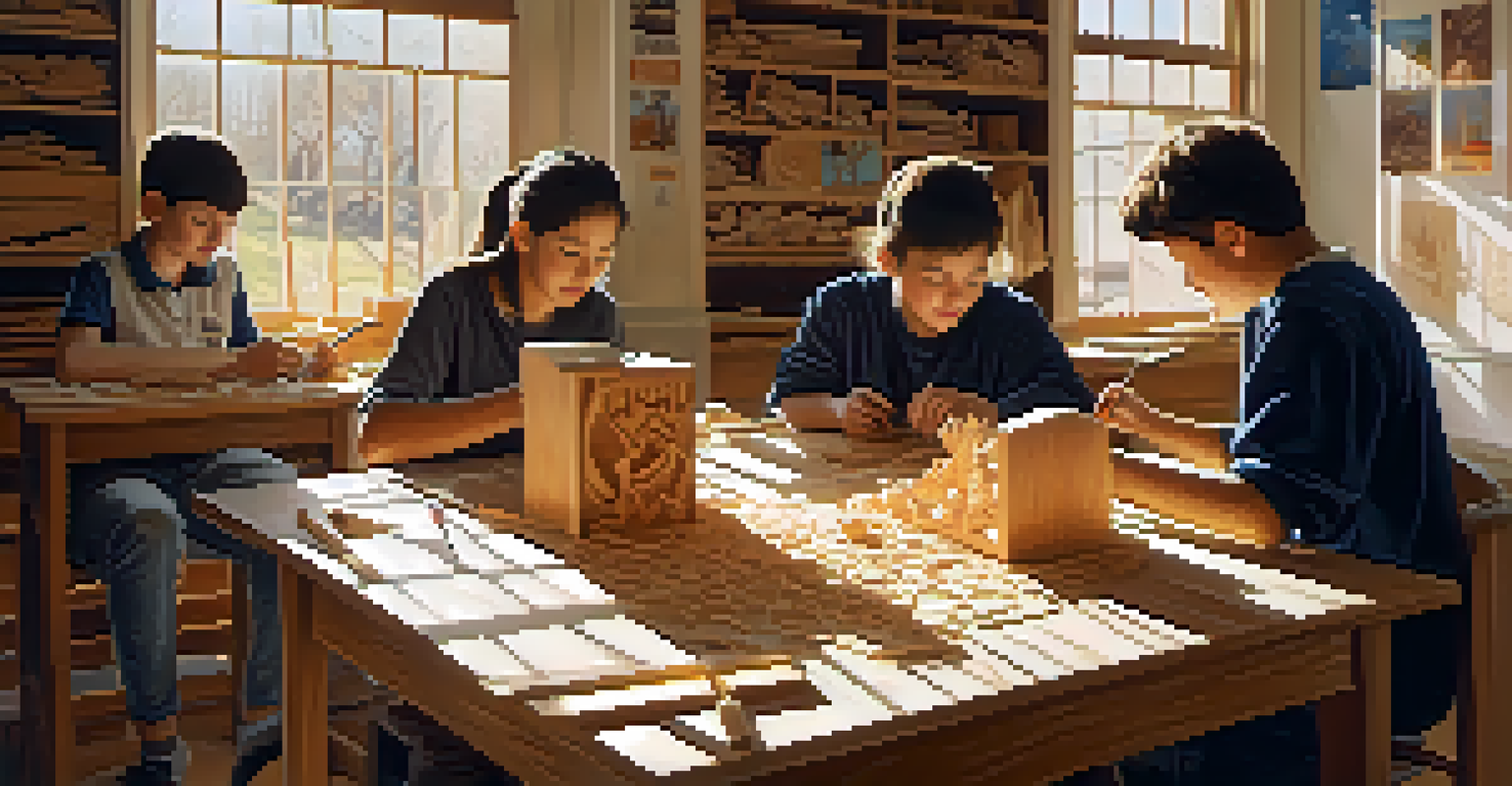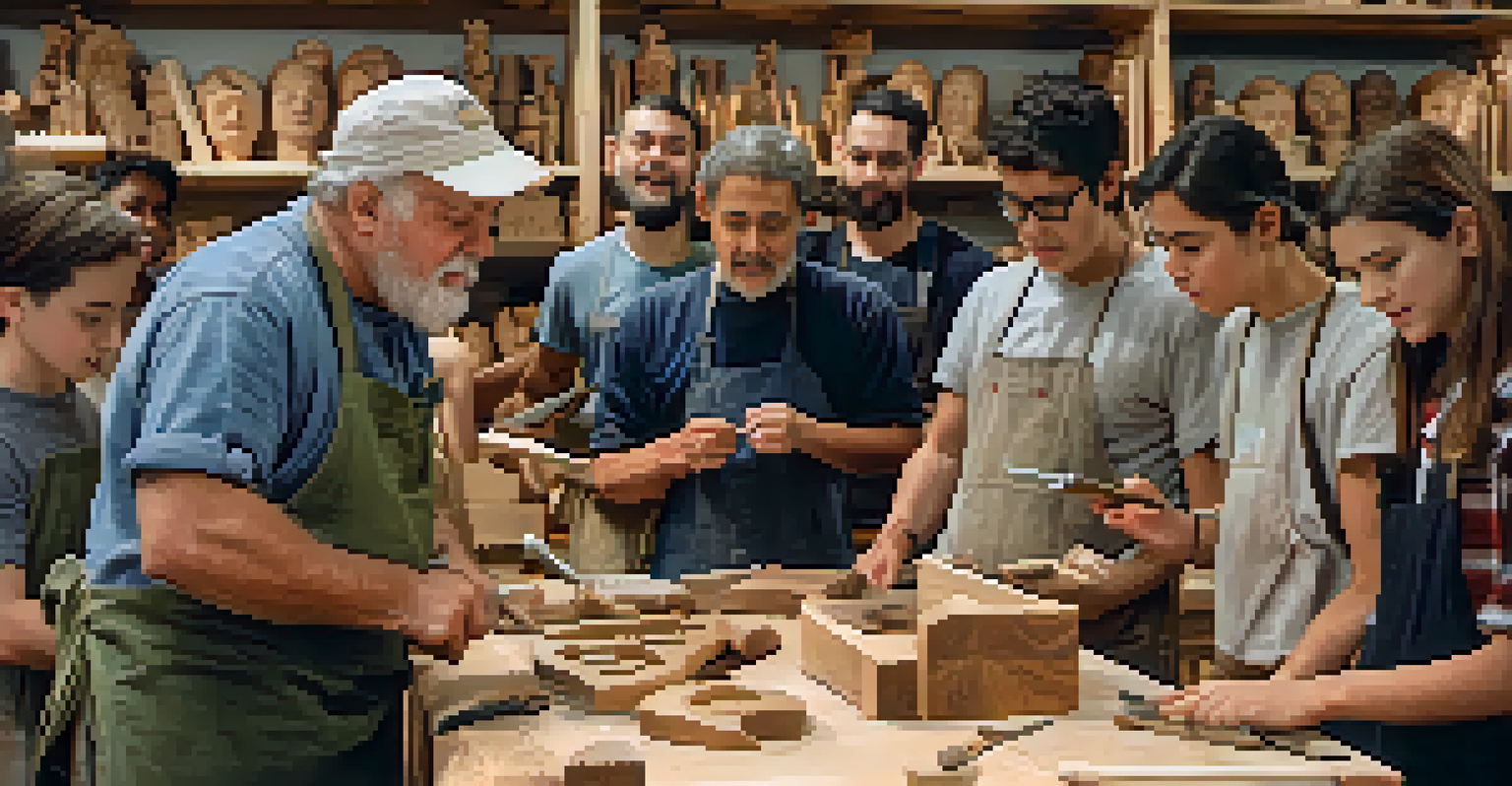Integrating Carving into STEM Education for Skill Development

Understanding the Role of Carving in STEM Education
Carving, often associated with art and crafts, can play a pivotal role in STEM education. It's not just about creating beautiful sculptures; it's about applying mathematical principles, physics, and engineering concepts in a tangible way. When students carve, they are engaging in a hands-on experience that reinforces theoretical knowledge.
The greatest scientists are artists as well.
For example, measuring and cutting materials helps students understand geometry, while the act of shaping a piece can introduce concepts of force and pressure. This kinesthetic learning approach can make abstract STEM concepts more relatable and easier to grasp. By integrating carving into STEM, educators provide a unique avenue for creativity and critical thinking.
Moreover, carving can spark interest in fields like engineering and design. Students often find joy in creating something physical, which can lead to deeper exploration of associated STEM topics. This integration not only enhances skill development but also fosters a love for learning in the process.
Benefits of Hands-On Learning through Carving
Hands-on learning is crucial in STEM education, and carving offers a prime example of this method. Engaging with materials directly allows students to see the immediate results of their actions, bridging the gap between theory and practice. When students carve, they develop fine motor skills, problem-solving abilities, and patience, all of which are essential in STEM fields.

Additionally, carving encourages a growth mindset. As students encounter challenges in their projects, they learn to adapt and refine their techniques, which mirrors the iterative process often found in scientific research and engineering. This resilience is a vital skill that translates well beyond the classroom.
Carving Enhances STEM Learning
Incorporating carving into STEM education provides hands-on experiences that deepen understanding of mathematical and engineering concepts.
Furthermore, the tactile experience of carving can enhance memory retention. Studies show that when students physically engage with their learning materials, they are more likely to remember the concepts associated with those activities. This means that carving can serve as a powerful tool for reinforcing STEM knowledge.
Incorporating Carving into the Curriculum
To effectively integrate carving into STEM education, teachers can design projects that align with learning objectives. For instance, a project involving the carving of geometric shapes can help students grasp concepts like surface area and volume. This not only makes learning fun but also contextualizes the importance of math in everyday life.
Creativity is intelligence having fun.
Teachers can also collaborate with local artisans or craft organizations to provide workshops and demonstrations. This partnership can expose students to professional techniques and the real-world applications of their skills. Such experiences help students appreciate the relevance of their education and inspire future career paths.
Moreover, utilizing technology alongside traditional carving methods can enhance the learning experience. For instance, students could use design software to plan their carvings before executing them physically. This blend of digital and hands-on learning prepares students for modern STEM careers, where proficiency in both areas is often required.
Developing Critical Thinking Skills through Carving
Carving is an excellent medium for developing critical thinking skills, a cornerstone of STEM education. As students plan their projects, they must consider various factors, such as material properties and design feasibility. This analytical approach encourages them to think critically about their decisions and the implications of their work.
Additionally, troubleshooting is a natural part of the carving process. When a piece doesn't turn out as expected, students must evaluate what went wrong and devise a new strategy to overcome the obstacle. This problem-solving aspect is invaluable, as it mirrors real-life scenarios they may face in STEM careers.
Fosters Critical Thinking Skills
The carving process encourages students to analyze, troubleshoot, and devise solutions, mirroring real-world problem-solving in STEM careers.
Ultimately, the critical thinking fostered through carving extends beyond the classroom. Students learn to approach challenges with a thoughtful mindset, preparing them for complex problem-solving tasks in their future endeavors. This skill set is essential for success in any STEM-related field.
Promoting Collaboration through Group Carving Projects
Group projects are a fantastic way to integrate collaboration into STEM learning, and carving projects are no exception. When students work together to create a carved piece, they must communicate effectively, share ideas, and delegate tasks. This collaborative effort fosters teamwork skills that are highly valued in the workplace.
For instance, in a group carving project, students might take on different roles, such as design, execution, and finishing touches. Each member's unique contributions can lead to a more refined final product and help students appreciate diverse perspectives. This sense of camaraderie can also enhance their overall learning experience.
Moreover, collaborative projects can stimulate creativity and innovation. When students brainstorm together, they often come up with ideas they might not have thought of individually. This collective creativity can lead to more complex and intricate carvings, making the learning experience even more rewarding.
Enhancing Fine Motor Skills and Coordination
One of the often-overlooked benefits of carving in STEM education is its positive impact on fine motor skills and hand-eye coordination. As students carve, they must control their tools with precision, which helps strengthen these essential skills. Fine motor development is crucial not only in artistic endeavors but also in many STEM fields, such as robotics and engineering.
For instance, when students carve detailed designs, they learn to manipulate tools with accuracy. This skill translates to tasks like soldering in electronics or assembling intricate models in engineering. The practice they gain through carving can give them a head start in more advanced STEM activities.
Promotes Collaboration and Creativity
Group carving projects enhance teamwork and innovation, allowing students to share ideas and develop a greater appreciation for diverse perspectives.
Additionally, enhanced coordination can lead to greater confidence in handling various tools and materials. As students become more adept at carving, they may be more willing to experiment with other hands-on projects, further enriching their STEM education. This confidence can significantly influence their passion for pursuing STEM careers in the future.
Fostering Creativity within STEM Disciplines
Creativity is often seen as the domain of the arts, but it's equally vital in STEM fields. Carving provides a unique platform for students to express their artistic side while engaging with scientific principles. By allowing students to create freely, educators can nurture their innovative thinking, which is essential for problem-solving in STEM.
When students carve, they are not just following instructions; they are making decisions about design, shape, and technique. This freedom to explore and experiment encourages them to think outside the box. Such creative thinking is crucial in STEM careers, where new solutions to complex problems are constantly needed.

Furthermore, integrating creativity into STEM education can make learning more enjoyable. Students who see the connection between art and science may be more inclined to pursue careers in fields like architecture, industrial design, or even environmental science. By fostering creativity through carving, educators can help shape the next generation of innovative thinkers.